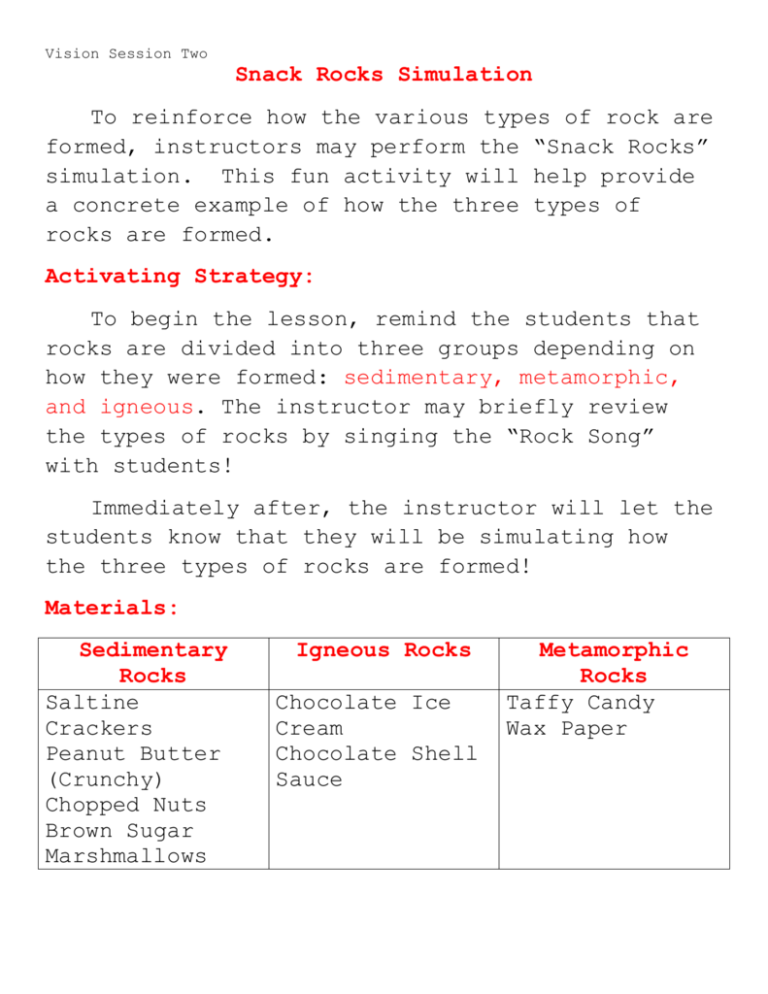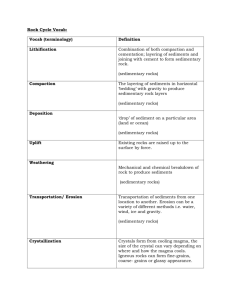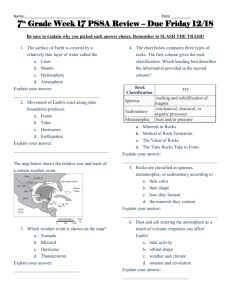Snack Rocks Simulation
advertisement

Vision Session Two Snack Rocks Simulation To reinforce how the various types of rock are formed, instructors may perform the “Snack Rocks” simulation. This fun activity will help provide a concrete example of how the three types of rocks are formed. Activating Strategy: To begin the lesson, remind the students that rocks are divided into three groups depending on how they were formed: sedimentary, metamorphic, and igneous. The instructor may briefly review the types of rocks by singing the “Rock Song” with students! Immediately after, the instructor will let the students know that they will be simulating how the three types of rocks are formed! Materials: Sedimentary Rocks Saltine Crackers Peanut Butter (Crunchy) Chopped Nuts Brown Sugar Marshmallows Igneous Rocks Chocolate Ice Cream Chocolate Shell Sauce Metamorphic Rocks Taffy Candy Wax Paper Vision Session Two Supplementary Materials: small bowls, plastic spoons, butcher paper, ice cream scooper After completing the activating strategy, the instructor will do the following: *Prior beginning the simulation, butcher paper must be placed over all student desks to warrant easy cleanup. 1. The instructor will place the students into cooperative groups of about 5-6 students. In these groups, students will use the various materials to simulate how the three types of rocks are formed. For each group of 5-6 students, the instructor will provide: 1 12 oz. bowl for each of the following: Crunchy Peanut Butter Brown Sugar Chopped Nuts Chocolate Ice Cream (Since the ice cream is prone to melting, the igneous simulation may be the last one performed.) Marshmallows The instructor will then provide each student with the following: Vision Session Two Sedimentary Rocks 2 Saltine Crackers Igneous Rocks Metamorphic Rocks 1 3 oz. cup of 2 Pieces of quick hardening Different chocolate shell Colored Taffy sauce Candy 2 5”x5” pieces of Wax Paper Each student will also receive their own plastic spoon. 2. After all materials have been provided to the students, the instructor will walk the students through the simulations, describing what EACH food item represents. For example, the instructor may say: “We will begin simulating how sedimentary rocks are formed. First, take one of your saltine crackers and lay it onto the butcher paper. This represents the bottom layer of your sedimentary rock. As we know, sedimentary rocks form when sand, bits of rock and soil, and oneliving organisms are pressed together and harden over time; this material is known as sediment. Rock is broken down into sediment over time through a process called weathering and is then deposited, or dropped, one top of one another. This creates layers that, over millions of years, form sedimentary rocks. Sedimentary rocks are usually found near water sources. Vision Session Two Next, take your plastic utensil and place some of the peanut butter onto your saltine cracker. The crunchy peanut butter represents bits of soil that have been eroded and deposited onto your first layer. Then, take your plastic utensil to scoop out some of the chopped nuts. These chopped pieces of nut represent the bits of rock that have been weathered over time. Please place these “bits of rock” on top of the layer of crunchy peanut butter. Do you notice that layers are starting to form? Now, please grab a few marshmallows to place onto the newest layer. These marshmallows represent fossilized organisms, for we know that sedimentary rocks are the types of rocks in which we will find fossils! We are most likely to find fossils in sedimentary rocks because fossils form when an animal, plant, or other signs of life such as a dinosaur footprint becomes buried in sediment. The layers of sediment build up and eventually form a sedimentary rock. Then, grab your utensil once more to scoop some more peanut butter. Again, this represents bits of soil that have been deposited. Then, using your fingertips, grab a few pinches of brown sugar. This represents the bits of sand that have Vision Session Two been deposited! Lastly, add another one of your saltine crackers as the final layer. Now we have formed a sedimentary rock!” Of course, the instructor will ask students pertinent questions to maintain a high level of thinking as the simulation is being performed. These can be discussed as a class, or students may jot down responses in their science notebooks as they move through the simulation. Just as the sedimentary rock formation process was thoroughly reviewed and the purpose of the food items were explained, the instructor will do the same for both igneous and metamorphic rock. Once the students have completed their sedimentary rock, they will place it to the side and begin forming their next “rocks” – metamorphic rocks. The instructor will ask the students to do the following: Take both pieces of your taffy candy and carefully remove the wrappers. Place the two taffy candies one on top of the other and form a “rock” shape. We will say that this rock begins as a sedimentary one because the layers of taffy candy show layers. Vision Session Two Take one of your wax paper sheets and place it onto the butcher paper. Place your “sedimentary rock” on to the wax paper. Grab the other piece of wax paper and place it on top of the “rock”. The students will use their hands to simulate extreme heat and pressure to change the physical attributes of the rock. Through doing this, the students have watched the initial rock transform into another through extreme heat and pressure. At this time, the instructor may have the students compare the characteristics of the rock before applying the pressure to transform the rock and the characteristics after. Once the students have completed their metamorphic rock, they will place it to the side and begin forming their next “rocks” – igneous rocks. The instructor will do the following: Provide each student with a 1 12 oz. bowl of one scoop of ice cream. Let the students know that the chocolate ice cream represents the earth’s surface. Students will be directed to, once all of them have received their ice cream,, to pour their quick-hardening chocolate shell sauce over the Vision Session Two ice cream. Let the students know that the chocolate sauce represents lava. As the students pour the liquid chocolate onto the ice cream surface, tell the children that when there is a volcano the magma is forced through the earth’s surface and comes out as lava. It then hardens as it cools and turns into igneous rock in the same way that the chocolate will harden as it cools over the ice cream’s surface. Follow-Up Writing Activities: *Describe the simulation that we completed today from start to finish. Do you feel that this simulation was a good example of showing how sedimentary, igneous, and metamorphic rock is formed? Why or why not? *Describe, in writing, what you feel are some other ways that we can simulate how igneous, sedimentary, or metamorphic rocks are formed? Vision Session Two The Rock Song Sedimentary Rock Has been formed in layers Often found near water sources With fossils from decayers Then there’s igneous rock Here since earth was born Molten lava cooled and hardened That‘s how it was formed Vision Session Two These two types of rock Can also be transformed With Pressure, heat, and chemicals Metamorphic they’ll become.









